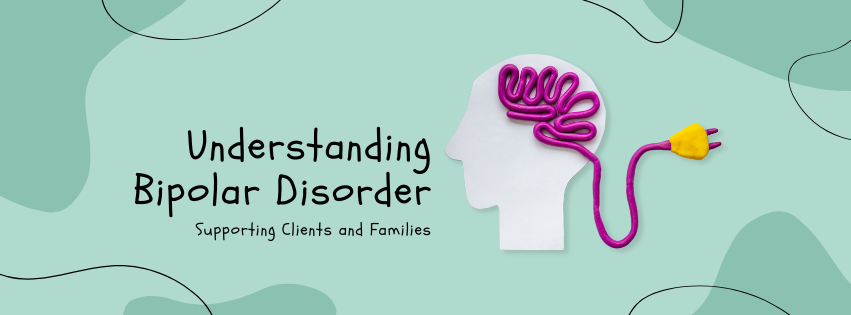Bipolar disorder is a chronic mood condition characterized by alternating periods of elevated mood (mania or hypomania) and depression. These shifts can affect energy levels, sleep patterns, behavior, and the ability to function in daily life (American Psychiatric Association, 2013). Although the exact cause remains unknown, a combination of genetic, biochemical, and environmental factors is believed to contribute to its development.
Signs and Symptoms of Bipolar Disorder
- Manic or Hypomanic Episodes
- Elevated or irritable mood, increased energy or activity
- Decreased need for sleep
- Racing thoughts, rapid speech
- Impulsive or risk-taking behaviors (e.g., spending sprees, substance misuse)
- Grandiose beliefs or inflated self-esteem (American Psychiatric Association, 2013)
- Depressive Episodes
- Persistent sadness or emptiness
- Loss of interest in previously enjoyed activities
- Changes in appetite or weight
- Sleep disturbances (insomnia or hypersomnia)
- Feelings of worthlessness or excessive guilt
- Difficulty concentrating and thoughts of death or suicide (Miklowitz & Johnson, 2006)
Treatment Options for Bipolar Disorder
Effective management of bipolar disorder typically involves a combination of approaches:
- Medication
- Mood Stabilizers (e.g., lithium, valproate)
- Atypical Antipsychotics (e.g., quetiapine, olanzapine)
- Antidepressants (often used cautiously and combined with a mood stabilizer) (Geddes & Miklowitz, 2013)
- Psychotherapy
- Cognitive Behavioral Therapy (CBT) to identify and modify unhelpful thought patterns
- Interpersonal and Social Rhythm Therapy (IPSRT) to stabilize daily routines and social rhythms
- Family-Focused Therapy to improve communication and problem-solving within the family system (Miklowitz, 2008)
- Lifestyle and Self-Management
- Maintaining a regular sleep–wake schedule
- Engaging in regular physical activity
- Monitoring mood daily (e.g., mood charts)
- Avoiding alcohol and non-prescribed substances
Supporting Clients and Families
- Education and Communication
- Learn about bipolar disorder’s course and treatment
- Set realistic expectations and collaboratively develop a crisis plan
- Practice open, non-judgmental communication—use “I” statements to express concerns
- Establishing Structure
- Help maintain consistent daily routines (sleep, meals, activity)
- Encourage participation in support groups or structured activities
- Empathy and Boundaries
- Validate emotions (“I hear that you’re feeling…”), even during mood highs or lows
- Set clear boundaries around safety (e.g., finances, driving) during manic episodes
- Self-Care for Caregivers
- Join family support groups (see Resources below)
- Access respite care or counseling to manage caregiver stress
Resources for Support
- National Alliance on Mental Illness (NAMI)
Provides education, support groups, and advocacy for individuals and families:
National Alliance on Mental Illness. (2024). Bipolar disorder. https://www.nami.org/About-Mental-Illness/Mental-Health-Conditions/Bipolar-Disorder - Depression and Bipolar Support Alliance (DBSA)
Offers peer-led support groups and online tools:
Depression and Bipolar Support Alliance. (2024). Find support. https://www.dbsalliance.org/support/ - Mississippi Department of Mental Health
Connects residents with local treatment and support services:
Mississippi Department of Mental Health. (n.d.). Find services. https://www.dmh.ms.gov/ - Crisis Text Line
24/7 crisis support via text. Text “HOME” to 741741 (U.S.)
References
American Psychiatric Association. (2013). Diagnostic and statistical manual of mental disorders (5th ed., text rev.). https://doi.org/10.1176/appi.books.9780890425596
Depression and Bipolar Support Alliance. (2024). Find support. https://www.dbsalliance.org/support/
Geddes, J. R., & Miklowitz, D. J. (2013). Treatment of bipolar disorder. The Lancet, 381(9878), 1672–1682. https://doi.org/10.1016/S0140-6736(13)60857-0
Miklowitz, D. J. (2008). Bipolar disorder: A family-focused treatment approach (2nd ed.). Guilford Press.
Miklowitz, D. J., & Johnson, S. L. (2006). The psychopathology and treatment of bipolar disorder. Annual Review of Clinical Psychology, 2(1), 199–235. https://doi.org/10.1146/annurev.clinpsy.2.022305.095229
Mississippi Department of Mental Health. (n.d.). Find services. https://www.dmh.ms.gov/
National Alliance on Mental Illness. (2024). Bipolar disorder. https://www.nami.org/About-Mental-Illness/Mental-Health-Conditions/Bipolar-Disorder
